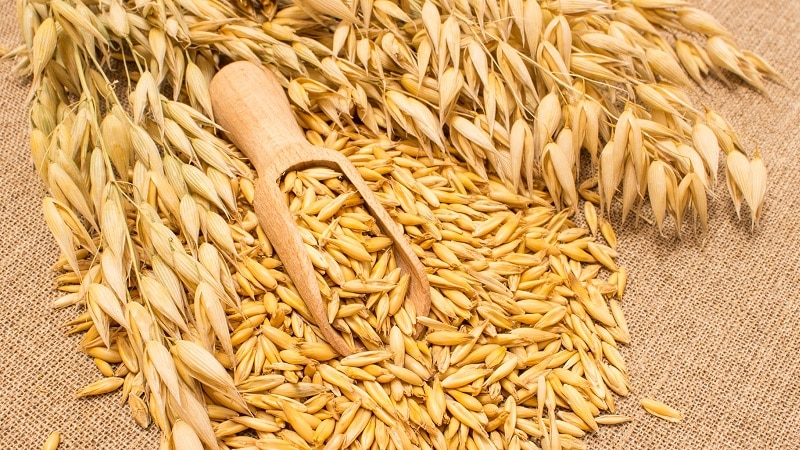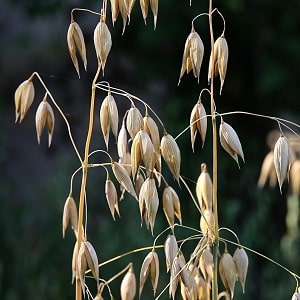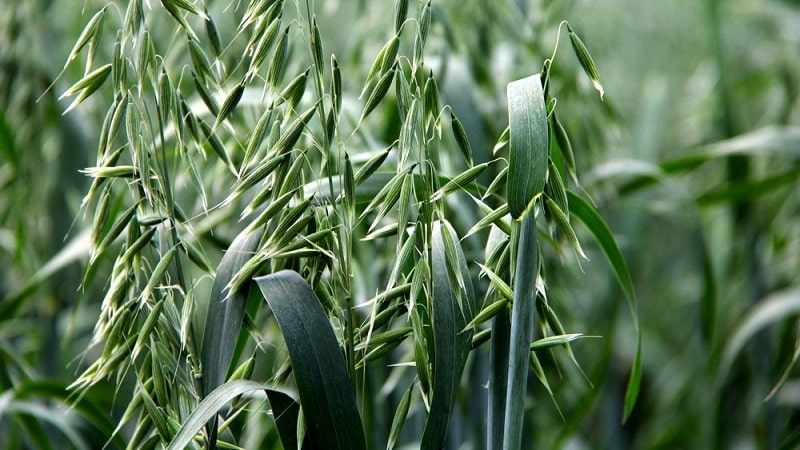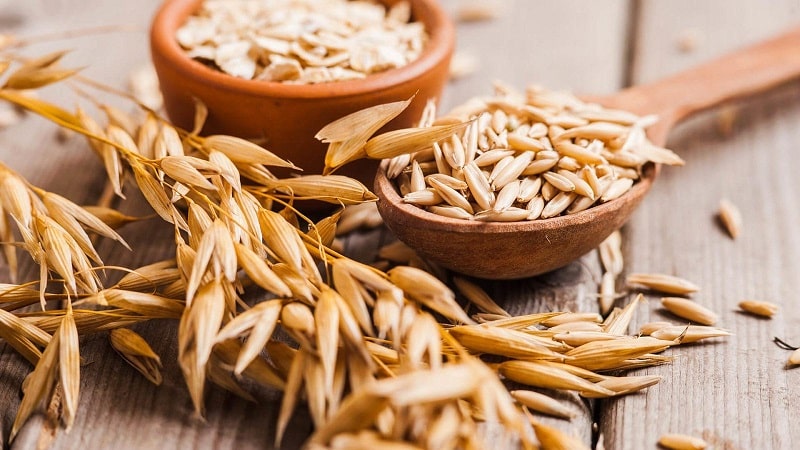What is oats - full description and biological features
Oats are a grain crop widely used in agriculture. It is grown all over the world - from Russia to the USA and Australia. Oat grains are used in cooking and medicine, as livestock feed, green manure and natural fertilizer.
What are oats
Oats are an annual crop of the Poaceae family (Poaceae, True Grasses).. It has been widely used in agriculture for several thousand years. It has earned its popularity due to its adaptability to various natural conditions and high content of nutrients.
Important! This is the most cold-resistant crop among grains. Oat seeds can germinate at temperatures of +1...+2°C, and crops can withstand frosts down to -9°C.
The culture dates back to the early. The homeland of oats is the northeastern province of China and Mongolia.
Winter or spring oats are planted in the fields.

Winter oats
Valuable grain green manure, cold-resistant food grain. In central Russia, sowing begins in early September. The seeding depth is 3.5 cm. Consumption is 14 g per 1 sq. m. m. When the plants reach 30-40 cm, they are covered with a layer of mulch. Harvesting occurs when the plant reaches 60 cm in height.
Spring oats
Herbaceous annual plant. In central Russia, sowing begins in mid-May. Suitable for planting with climbing legumes due to its strong stem. Seeds must be lowered to a depth of 4-5 cm.Oats ripen unevenly, so harvesting occurs when 60% of the grains are in waxy ripeness. It is not recommended to sow a plant in the same place for two years in a row - this leads to low yields due to diseases and depleted soil.
Reference. The Russian Federation is a leader in oat cultivation. The area it occupies is 8.5 million hectares.
Biological and morphological features
Oats consists of root, stem, leaves and panicle. The stem is straight, thin, straw-like. Long leaves with pointed ends are located alternately along the stem.
 What kind of inflorescence does common and common oats have? In both cultures it is called a panicle. Consists of large hanging spikelets with 2-3 flowers. The lower flower scales are incised at the apex, bi-awned or two-toothed, with a strong awn on the back, less often without an awn. At the apex there is a hairy ovary. The fruit of oats is a grain, pubescent over the entire surface.
What kind of inflorescence does common and common oats have? In both cultures it is called a panicle. Consists of large hanging spikelets with 2-3 flowers. The lower flower scales are incised at the apex, bi-awned or two-toothed, with a strong awn on the back, less often without an awn. At the apex there is a hairy ovary. The fruit of oats is a grain, pubescent over the entire surface.
The root system is fibrous, well developed and can penetrate the soil to a depth of 120 cm. It has the ability to well absorb poorly soluble elements from the soil. About 80-90% of oat rhizomes are located in the arable layer. The surface of the system is increased due to the large number of root hairs.
The culture is undemanding to heat. Already +1…+2°С is enough for the seeds to begin to germinate. The period from sowing to germination depends on temperature and is 20 days at +5°C and a week at +15°C. It is good if during the period of germination and the beginning of booting the air temperature is +12...+16°C, and during the period of flowering and grain filling - no more than +22°C.
Attention! Young seedlings can withstand frosts down to -8°C, but during the flowering period a temperature of -2°C can already destroy the plant.
Due to the fact that the root system develops quickly and powerfully absorbs moisture from the soil, oats are more resistant to spring drought, how barley and spring wheat. On the contrary, it tolerates summer droughts worse. Temperatures of +38…+40°C are already destructive for him.
Oats are not picky about soil, but soddy-podzolic sandy loam and light loam are still preferable for its cultivation.. This is due to the fact that for normal development the root system requires a large amount of oxygen. The oat root system has a high absorptive capacity due to the large number of highly active root hairs. They occupy 90% of the entire surface of the root system.
For good growth and full development, oats require potassium, phosphorus and nitrogen.. The need for phosphorus is greatest in the early stages of development and growth. Potassium is needed at all stages.
Oats - a plant of long daylight hours. At the initial stage, a little light is enough for him. During the flowering phase, the duration of daylight should be at least 13 hours a day. Failure to comply with this rule will result in the oats continuing to grow, but the flowering period will not occur. In the future, for normal development, it is important that daylight hours range from 14 to 16 hours. After fruiting is completed, further growth does not depend on the length of daylight hours.

Chemical composition of grain
The chemical composition of grains depends on the variety and growing conditions. Averages:
- 9-19.5% proteins;
- 65-89% carbohydrates;
- 3-12% fat;
- 0.5-2% disaccharides;
- 10-15% fiber;
- 8-12% hemicellulose;
- 0.15-0.2% monosaccharides;
- 33-45% starch.
Minerals:
- 355 mg potassium;
- 340 mg phosphorus;
- 130 mg magnesium;
- 80 mg calcium;
- 8 mg sodium;
- 5.8 mg iron;
- 3.2 mg zinc;
- 3.1 mg manganese;
- 0.42 mg copper;
- 7 mcg selenium.
Interesting things on the site:
Vitamins:
- 2400 mcg niacin (B3);
- 960 mcg vitamin B6;
- 840 mcg vitamin E;
- 710 mcg pantothenic acid (B5);
- 675 mcg thiamine (B1);
- 170 mcg riboflavin (B2);
- 35 mcg folic acid.
Amino acids:
- 1020 mg leucine;
- 850 mg arginine;
- 790 mg valine;
- 700 mg phenylalanine;
- 560 mg isoleucine;
- 550 mg lysine;
- 490 mg threonine;
- 450 mg tyrosine;
- 270 mg histidine;
- 230 mg methionine;
- 190 mg tryptophan.
Regarding calories: The most calorie-dense unprocessed grain. They contain 389 kcal per 100 g. Instant oat flakes - 369 kcal. Long-cooked oatmeal (62 kcal) and oat bran (40 kcal) are considered the lowest in calories.

Shelf life and storage conditions
Oats retain their seed quality for 3 years under optimal storage conditions. Germination can last up to 7-10 years, but every year it decreases by 1%. It is not recommended to store processed oats for more than 1.5 years.
After harvesting and threshing, the grain is delivered to grain drying complexes, where it is dried and filtered. Thanks to this, grain moisture does not exceed 12-14%. Next, the grain is cooled to +10…+15°C.
Oats are stored in a dry, clean granary with good ventilation. Storage occurs not only in dry conditions, but also in refrigerated or sealed conditions. This allows you to pause the internal processes of the seeds and extend their viability.
Conclusion
Oats are an unpretentious plant, considered the leader among cereals in terms of vitamins and amino acids. It is not for nothing that this grain crop was one of the most important for our ancestors.And dishes prepared from oatmeal have been the basis of the diet of the Russian population for many centuries.